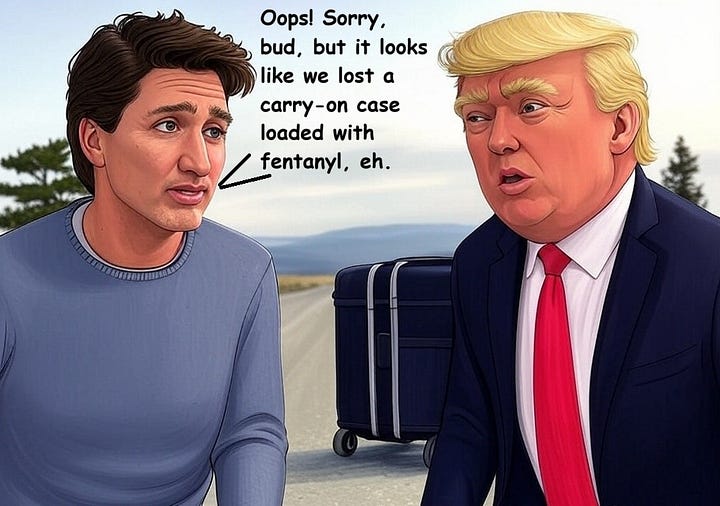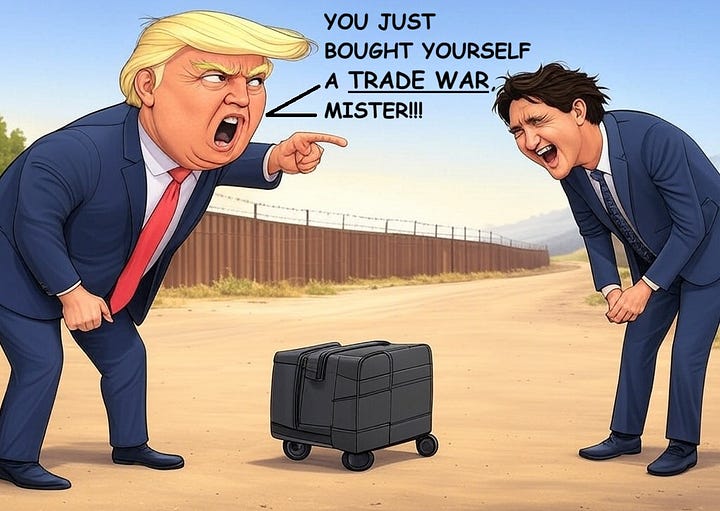“Much has been said over the last three months about Mexico and Canada. But we have very large deficits with both of them. But even more importantly, they have allowed fentanyl to come into our country at levels never seen before, killing hundreds of thousands of our citizens and many very young, beautiful people, destroying families. Nobody’s ever seen anything like it.” ~ Donald Trump at his Joint Address to Congress on March 4, 2025.
The same person who brought you the “War on Covid,” is now also bringing new instalments of the “War on Terror” (aimed at migrants) and a “War on Drugs” (fentanyl). For someone who claimed to be against war mongers, Trump certainly has a proclivity to declare numerous wars of his own, all of which share at least three key elements in common:
they are invented emergencies based on fake crises;
the “wars” have not been declared by Congress; and,
these Executive “wars,” particularly Trump’s pretended war on fentanyl, are unwinnable.
The Manipulation of Feelings Requires Manipulated Data
We are told by his supporters, and by himself, that Trump cares about the impact of fentanyl on US lives. One would think that if that were true, then he would deem it highly inappropriate and disrespectful to the victims and their families to use their plight in a manipulative manner in order to fabricate a basis for what is in fact a trade war. That trade war is, in turn, a basis for maximizing his own power and the wealth of his friends.
While nobody wishes to trivialize or minimize the importance of any preventable deaths, one cannot avoid how those deaths are being hyped by Trump, in a cynical manner. Deaths from overdoses of all drugs (not just fentanyl) peaked in the US in 2022 and 2023, causing more than 111,000 fatalities per year. Yet on Inauguration Day, Trump said foreign drug cartels are “killing 250,000 [or] 300,000 American people per year”. Here Trump is inflating mortality statistics in the same ways that critics said was done during the “Covid response”. Indeed, the lockdowns that Trump championed as part of his militarized Operation Warp Speed response, themselves contributed to an increase in the abuse of narcotics.
The timing of tariffs also points to the fabrication of a fictional drug war. By the date this article was written, US deaths from fentanyl overdoses had been declining sharply. This decline happened well before any tariffs were even announced. Enhanced border security, increased coordination with Mexico and China, and domestic campaigns of harm reduction apparently proved successful—nothing to do with trade, however.
Even in a single short response, Trump slides from complaining about the entry of drugs (he never addresses US demand), to speaking about tariffs and financial advantage. He does so by producing a complete inversion of Dependency Theory and World-Systems Analysis: the US, a core nation, a hegemon, is now cast as a poor, exploited, peripheral nation. This is how he taps into the Myth of American Innocence. There is a substantial amount of pathos attached to MAGA self-representations.
Likewise, when Trump is ready to declare “victory,” that he achieved “success” in stopping the flow of fentanyl into the US, he can invent his own metrics for doing so—because he has not abided by any metrics to this point. We can expect such a declaration of victory when his trade war against the US’ biggest trading partners, Canada and Mexico, proves too damaging for the US economy.
There is No Emergency
As alluded to above, Trump is declaring emergency measures at the same time that the alleged “emergency” is in decline, according to figures from the CDC: “after years of rising overdose deaths, the United States recorded 87,000 drug overdose deaths from October 2023 to September 2024, a decrease from 114,000 the previous year”. That is a decline of nearly 24%. Moreover, the fixation on fentanyl is unhelpful, as new and even more potent drug variants are emerging. The fact that fentanyl alone is made to occupy centre-stage in these debates is itself an indication that the focus of this “drug war” is disingenuous.
The Canadian “fentanyl threat” is indeed an invention, and at the very least an exaggeration. On his day of inauguration, Trump asserted: “The fentanyl coming through Canada is massive”. Canada accounts for at most 0.2% of the fentanyl entering the US. Only the fear-mongering hyperbole is massive, and massively transparent. In fact, none of Trump’s many other claims about Canada stand the test of scrutiny.
That US trade actions against Canada—in the name of an alleged “public health emergency”—involve a fabrication of reality is something that can be tested by examining a number of glaring discrepancies between the stated justification and the actual evidence. On March 4, Trump imposed tariffs on goods from Canada and Mexico under the International Emergency Economic Powers Act (IEEPA) of 1977, which allows the president to “act without congressional approval in the event of a national emergency”. He declared a “public health emergency,” using the same language from the Covid period.
US Customs and Border Protection data from fiscal year 2024 shows that only 43 pounds of fentanyl were seized at the Canadian border—and even that figure was inflated, as one-third was sourced from Mexico. This is what prompted one journalist to question how what amounts to a carry-on case worth of drugs, is the focus of the Trump regime’s melodramatic hyperbole against Canada. Canada accounts for roughly 0.2% of total fentanyl seizures—in other words, an insignificant fraction that, when rounded off, is zero. The response to the reporter from the White House press secretary was typical “lying with statistics”: that 43 pounds represented a “2,050% increase” from the year prior—which sounds massive, but it is also a case of a number rising from almost nothing to just a little something:
Most of the inflated figure of 43 pounds in 2024 involves transactions on the border with Spokane, Washington—not the entirety of the Canadian border, as Trump would suggest. In addition, it was found that in the figures produced by US authorities,
“the dataset does not reveal the origin of the drugs and U.S. border agents confirmed that the methodology used for attributing seizures to the northern border doesn’t hinge on whether the fentanyl was intercepted at the border or whether it came from Canada. It could have been seized hundreds of kilometres inland, and it may have no ties to Canada whatsoever” [emphasis added].
Exaggerating a threat should be the first sign that the alleged threat is just a pretext.
A Trade War Masked as a Drug War
Few would expect that talk about the horrors of fentanyl addictions and deaths, would then be suddenly spliced with diatribes about trade deficits, “nasty” trade negotiators, automobile manufacturing, dairy, and desires for a 51st state. Such is the case with Trump’s additional Executive Order titled, “Imposing Duties to Address the Flow of Illicit Drugs across our Northern Border”. Continuing the invocation of the IEEPA and the National Emergency Act—misleadingly as a response to a “public health emergency”—this document outlines in fine detail all the measures and countermeasures the US will adopt on trade. The document is bereft of any mention of what the US will do to increase drug interdiction in the US, to strengthen its own borders, or how it will address the root causes of fentanyl addiction. Instead, we get this in Section 2 (d):
“Should Canada retaliate against the United States in response to this action through import duties on United States exports to Canada or similar measures, the President may increase or expand in scope the duties imposed under this order to ensure the efficacy of this action”.
That is a trade war, not a drug war.
Making Up the Canadian Threat
The fentanyl hoax has also featured sporadic rhetorical outbursts from Trump regime officials around Canada’s alleged fentanyl labs and criminal networks, along with unsubstantiated claims of “secret evidence” of unchecked drug operations. Trump’s trade advisor, Peter Navarro, an ex-con and proven liar, went even so far as to spin the tale that Canada had been taken over by Mexican cartels:
Yet the DEA itself has corroborated none of Trump’s claims about Canada: its 2024 National Drug Threat Assessment did not even mention Canada as a significant source of illegal drugs.
This absence of a Canadian threat continues into 2025. The just released Annual Threat Assessment by US intelligence agencies, does not mention Canada as a source of fentanyl. In fact, it does not mention Canada at all, not even once. Furthermore, in 2024 the DEA’s own National Drug Threat Assessment did not mention Canada, again not even once—the 43 pounds registered for that year counted for nothing, even for the DEA.
The Globe and Mail noted the following about US claims and how they deflect:
“During the hearing [with Tulsi Gabbard, the Director of National Intelligence], Democratic Senator Martin Heinrich of New Mexico pressed Ms. Gabbard about Canada’s omission from the report and said he was surprised the country was not mentioned given Mr. Trump’s rhetoric. Ms. Gabbard said the focus of the ATA is on the ‛most extreme threats,’ and its assessment is that the most extreme threat is ‛from and through Mexico’.
“When asked for comment on Tuesday, the White House referred the request to the Office of the Director of National Intelligence, which said it had nothing to share beyond what was in the report”.
Canada’s commitment, under Justin Trudeau, to spend a whopping $1.3 billion on re-securing the border with the US, increasing drug interdiction efforts, classifying cartels as “terrorists,” and appointing a “border czar” (which has no meaning under Canadian laws), would thus appear to be massive overkill. If anything, it helped to validate Trump’s fiction of an emergency situation. One has to ask why Trudeau would do that. What Trump has done is to create an emergency atmosphere in Canada. As a result, the parties seen as more distant from, and most opposed to Trump—the Liberals and NDP—were those that stood to gain the most from impending elections. Trump has created a “crisis,” and that is something that can be exploited on both sides of the border.
My advice would have been to do nothing at all to comply with Trump’s capricious demands—and, in the end, it would not have mattered, as Canada’s commitments were waved aside by Trump as he pushes ahead with his real aim: a trade war, at all costs.
Even in the case of Mexico, Trump engages in invention. Trump is now boasting that the southern border is now secure, thanks to his efforts. If it is secure, then how is fentanyl getting in? Obviously one cannot have it both ways. Thus his Mexican strategy required an alteration in his fabulist narrative. The assertion now is that the fentanyl that has stopped coming into the US through Mexico, is somehow going up to Canada and then coming back down. At no point is any evidence presented—because this is Trump, and his war on drugs is as much a war on realism. Also left unanswered is why he would not then totally exempt Mexico from any tariffs, if the border has now been secured.
Wrong Tools, Wrong Outcomes
In terms of justification, take note of the fact that there is no theory, no study, not even a half-decent blog post anywhere that suggests that drug flows are impeded by tariffs on wholly unrelated products, and by punishing consumers who have nothing to do with the fentanyl trade.
A trade war would also seem to be irrelevant for addressing a problem that is primarily American: “Trump’s new tariffs don’t address other ways fentanyl enters the United States, including smuggling by Americans. Americans were 80% of all people caught with fentanyl during border crossings at ports of entry from 2019 to 2024, according to CBP data obtained by the Cato Institute, a libertarian think tank” [emphasis added].
Claudia Sheinbaum, President of Mexico, made this very point:
Trump’s trade war could push Canada and Mexico into recessions, which would likely cause an increase in illicit activities by those displaced from the formal economy. This in turn could mean an increase in the production of fentanyl, and possibly an increase in addictions too as economic conditions worsen for the mass of citizens.
To impose trade restrictions now—and worse yet, to tax US consumers for having done nothing wrong—proves that the fentanyl narrative is a false one. It is designed to, at best, pull at the heart strings of the most gullible and most fervent of MAGA zealots.
The fentanyl hoax is being deployed to justify a “national emergency,” which then allows Trump to circumvent the legal provisions of the very trade agreement which he demanded, negotiated, signed, and then praised.
The perverse result is that the “victims of crime”—US citizens at the receiving end of the drug trade—are the ones being punished by their own government. The government does this by using tools irrelevant to the problem: taxing them on consumption, and increasing the costs of production. They are sold the promise that, in the unspecified “long term,” the US will become a manufacturing “powerhouse” (it will not, but no matter)...but then what about the influx of drugs?
Rule by Emergency Requires an Emergency to be Invented
There is something about this fentanyl hoax that brings to mind other major international hoaxes of the past 25 years: the WMDs in Iraq myth, or Gaddafi threatened to massacre all of Benghazi. These come to my mind immediately. When one state falsely accuses another state of what amounts to a crime of mass murder, then that opens the door to justifying every manner of wild and barbaric action.
However, unlike those other hoaxes, Trump’s fentanyl hoax does not even try to avoid a semblance of fraud. To call it a cynical abuse of power is an understatement. What cannot be understated is that this new “emergency” will provide yet another set of reasons for people to distrust governments even more. People will not know what to believe any more, even if it is the truth. Besides a mad power grab, then that is perhaps the other part of Trump’s plan: rule by illusion.













Since this article was written, the US Senate has voted to block Trump's tariffs on Canada, specifically. The majority agreed: there is no "national emergency" caused by fentanyl coming in from Canada.
https://www.theguardian.com/us-news/2025/apr/02/republicans-democrats-canada-tariffs
As for the other two comments that are here, by Justin Swanson and Jesse Smith, I have no idea what they are trying to say, but I can see that one of them used the space as an opportunity to push his site.
I can appreciate the perspective that the Trump admins demands have not been made clear on fentanyl. As far as not being relevant to the scale of the trade war itself, I would disagree. Yes a little decline in deaths last year… but since the year 2000, in Canada overdoses are up over 562%.
That is a very serious concern, if he was serious about it he would want to see the Liberal Party fail at all costs but endorsed them to win the federal election.
https://1911ranch.substack.com/p/chin-ada-a-drug-lords-playground?r=59oa6p&utm_medium=ios